
The Consolidated Municipality of Carson City is an independent city and the capital of the U.S. state of Nevada. As of the 2020 census, the population was 58,639, making it the sixth largest city in Nevada. The majority of the city's population lives in Eagle Valley, on the eastern edge of the Carson Range, a branch of the Sierra Nevada, about 30 miles (50 km) south of Reno. The city is named after the mountain man Kit Carson. The town began as a stopover for California-bound immigrants, but developed into a city with the Comstock Lode, a silver strike in the mountains to the northeast. The city has served as Nevada's capital since statehood in 1864; for much of its history it was a hub for the Virginia and Truckee Railroad, although the tracks were removed in 1950.
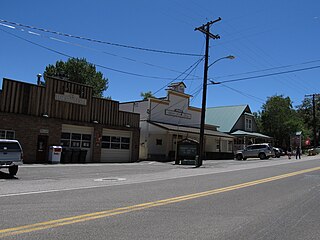
Genoa is an unincorporated town in Douglas County, Nevada, United States. Founded in 1851, it was the first settlement in what became the Nevada Territory. It is situated within Carson River Valley and is approximately 42 miles (68 km) south of Reno. The population was 939 at the 2010 census. It is home to the oldest bar in the state of Nevada which opened in 1853.
Frederic Joseph DeLongchamps was an American architect. He was one of Nevada's most prolific architects, yet is notable for entering the architectural profession with no extensive formal training. He has also been known as Frederick J. DeLongchamps, and was described by the latter name in an extensive review of the historic importance of his works which led to many of them being listed on the U.S. National Register of Historic Places in the 1980s.

The Carson City Mint was a branch of the United States Mint in Carson City, Nevada. It primarily minted silver coins; however, it also minted gold coins, with a total face value in dollars nearly equal to that of its silver coins. The mint minted coins in 21 different years.

The Nevada State Capitol is the capitol building of the U.S. state of Nevada located in the state capital of Carson City at 101 North Carson Street. The building was constructed in the Neoclassical Italianate style between 1869 and 1871. It is listed in the National Register of Historic Places. It is also Nevada Historical Marker number 25.

Fort Churchill State Historic Park is a state park of Nevada, United States, preserving the remains of a United States Army fort and a waystation on the Pony Express and Central Overland Routes dating back to the 1860s. The site is one end of the historic Fort Churchill and Sand Springs Toll Road. The park is in Lyon County south of the town of Silver Springs, on U.S. Route 95 Alternate, eight miles (13 km) south of U.S. Route 50. Fort Churchill was designated a National Historic Landmark in 1961. A 1994 park addition forms a corridor along the Carson River.

Kyle Ranch or Kiel Ranch, was one of the earliest ranches established in Nevada's Las Vegas Valley. Founded by Conrad Kiel in 1875, today the location of the former ranch is in North Las Vegas, where the city maintains the remnants of the site as the "Kiel Ranch Historic Park." The original adobe structure, one of the oldest buildings in Las Vegas, a wooden shed known as the "Doll House," and the cemetery are all that remain after loss of buildings through fire and neglect. Also within the park is an artesian well and a small wetlands, a reminder of what drew travelers and early settlers to the area. Presently the ranch's location is memorialized with Nevada Historical Marker number 224.
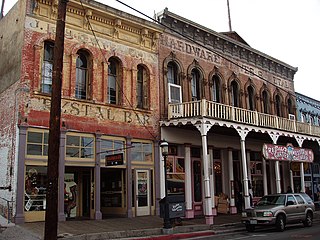

St. Paul's Episcopal Church is a historic Carpenter Gothic-style Episcopal church building located at F and Taylor Streets in Virginia City, Nevada, United States. It was built in 1876 to replace an earlier church that had burned down in 1875. St Paul's Parish, founded on September 1, 1861, is still an active congregation in the Episcopal Diocese of Nevada.

AbrahamVan Santvoord Curry is considered the founding father of Carson City, Nevada. A native of the state of New York, he traveled to the West Coast during the California Gold Rush and settled in Nevada's Eagle Valley, where Carson City was established.

St. Peter's Episcopal Church is a large historic Carpenter Gothic Episcopal church building located at the corner of Division and Telegraph streets in Carson City, Nevada. Built in 1868, it is the oldest Episcopal church still in use in Nevada. On January 3, 1978, it was listed on the National Register of Historic Places.
George A. Ferris & Son was an architectural firm in Reno, Nevada, consisting of partners George Ashmead Ferris (1859-1948) and his son Lehman "Monk" Ferris (1893-1996). The partnership lasted from just 1928 to 1932; both father and son however were individually prominent.
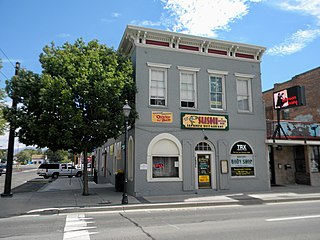
The Kitzmeyer Furniture Factory, at 319 N. Carson St. in Carson City, Nevada, is a historic building built in 1873. It is the oldest surviving Italianate-style commercial buildings in the commercial core area of Carson City.

The Lew M. Meder House, at 308 N. Nevada St. in Carson City, Nevada, United States, is a historic house with Late Victorian architecture that was built in 1876. It was listed on the National Register of Historic Places in 1978.

The Carson Brewing Company, at 102 S. Division St. in Carson City, Nevada, was built in 1864. Also known as the Carson City Nevada Appeal Building, it was listed on the National Register of Historic Places in 1978. It was originally a brewery and bar.

The David Smaill House, at 313 W. Ann St. in Carson City, Nevada, was built in c.1876. Also known as the Smaill House, it was listed on the National Register of Historic Places in 1985.
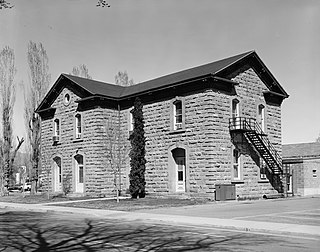
The Nevada State Printing Office, at 101 S. Fall St. in Carson City, Nevada, was built in 1885–86. Also known as the Old State Printing Office, it was a work of Reno architect M.J. Curtis. It is located across from the Nevada State Capitol building. Also known as the Old State Printing Office, it was a work of two architects named Morrill J. Curtis and Seymore Pixley. It is the second oldest State-built structure in the Capitol Complex.

The Foreman–Roberts House, formerly the James D. Roberts House and now also known as the Foreman–Roberts House Museum, is a historic house and museum located at 1217 N. Carson St. in Carson City, Nevada. The house was built in 1859 and was moved to the present location in 1873. Known also as the Thurman Roberts House for the last member of the Roberts family, it is listed on the National Register of Historic Places. It is the headquarters of the Carson City Historical Society and is open to the public by appointment and for special events.

The Gov. James W. Nye Mansion, at 108 N. Minnesota St. in Carson City, Nevada, United States, was built in 1860. It has also been known as St. Teresa's Rectory. It was a home of U.S. senator William M. Stewart and of Nevada territory governor James W. Nye.
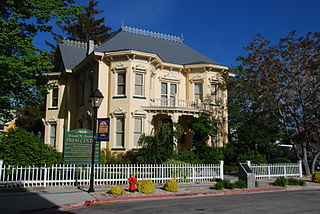
The Rinckel Mansion is a historic house in Carson City, Nevada, United States, that is listed on the National Register of Historic Places (NRHP).



















